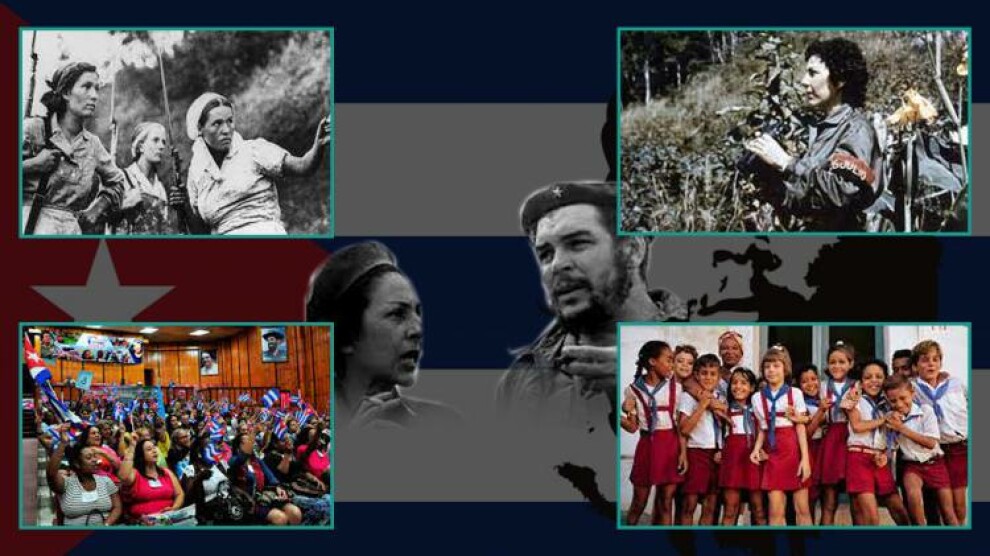Cuban Revolution led by women-1
Women at the frontlines of the resistance Cuban women, who became the symbol of the resistance in front of the whole world both before and after the Cuban Revolution, achieved significant success for people. Their struggle has become a model not only for Cuban society but also for all women around the world. Many revolutionary women such as Celia Sanchez, Vilma Espín, Teté Puebla and Nirma Cartón put their stamp on history. We draw attention to the resistance of Cuban women in this article series, which consists of seven articles.

Women at the frontlines of the resistance
Cuban women, who became the symbol of the resistance in front of the whole world both before and after the Cuban Revolution, achieved significant success for people. Their struggle has become a model not only for Cuban society but also for all women around the world. Many revolutionary women such as Celia Sanchez, Vilma Espín, Teté Puebla and Nirma Cartón put their stamp on history. We draw attention to the resistance of Cuban women in this article series, which consists of seven articles.
News Center-The population of Cuba was 6.5 million before 1958. One-fourth of the citizens were unemployed and the prices of food products were very high because the country imported them. The Cuban people faced pressure in all areas such as politics and the economy, and they couldn’t express their thoughts. When people protested the situation in the country, they were subjected to violence by the regime of Fulgencio Batista. In the 1950s, over 20,000 people were killed by the regime. In 1958, the country was controlled by Fulgencio Batista. The Cuban army consisted of 150,000 soldiers and the government led by Batista relied on this army. In December 1958, a battle broke out from two fronts in Santa Clara between the rebels and the regime of General Fulgencio Batista. Batista relied on his army and supporters.
Call for a general strike from a radio station on January 1
On January 1, 1959, a radio station in Cuba was given information about a meeting of the generals of the Cuban army. The meeting was to be held at the Colombian Military Base. Another radio station was reporting the change of some commanders of the Cuban army. Meanwhile, some contradictory news about the change of the president was heard. The Cuban army understood it was time for attack and immediately issued an order to attack Santiago because Commanders Che Guevara and Camilo would advance towards Havana.
“Revolution Yes, Military coup No!”
Fidel Castro and Celia Sanchez wrote an announcement of the Cuban Revolution in 10 minutes. On the first morning of the New Year, Fidel Castro used the Radio Rebelde to broadcast a call for another general strike. He rejected any attempts by the Cuban military to replace Fulgencio Batista with a coup d'état and urged his revolutionary force to press on to the cities of Havana and Santiago. His final words were, “Revolution Yes, Military coup No!”
After Fidel Castro read the announcement, Juan Nuiry, the representative of the Cuban student movement, called on the students to join Cuban revolutionaries. The number of Cuban revolutionaries was approximately 3,000 people. At the same time, Raúl Castro was advancing towards Santiago with revolutionaries. In 1953, they attacked Moncada Barracks with the same enthusiasm but they were defeated. But this time they would win and it would be the last attack…
Women putting their stamps on history
The Cuban Revolution was an armed revolt conducted by revolutionaries against the military dictatorship of General Fulgencio Batista. The struggle of the Cuban people against the dictatorship regime has developed important political and social effects in the national liberation struggle of many countries, particularly in South America and some African countries. The Cuban Revolution is the most colorful and original revolution of its period. Many people put their stamps on history by taking part in the revolution such as Haydée Santamaría Cuadrado, Celia Sanchez, Vilma Espín, Melba Hernandez, Aleida March, Lydia Doce, Clodomira Acosta, Teté Puebla, Nirma Cartón, Tamara Bunke Bider and many more…
They enshrined in the hearts of people
These people were active in the youth revolution of 1968. The impact of these revolutionaries keeps the Cuban Revolution alive despite the disintegration of real socialism. Their view of life sparked revolutions all around the world, particularly in Latin America. Their morale, enthusiasm, their spirit of resistance, courage, and self-sacrifice affected all segments of society. Their humanistic approach affected even their enemies. The success of the Cuban Revolution, the courage, and the sacrifices of these people enshrined in the hearts of people.
Before the Cuban revolution, women were unorganized. Women took part in action one by one. At the beginning of the revolution, Cuban women began to take important responsibilities and had a positive impact on society. The path of these revolutionaries changed the norms of their society. In time, they became successful in their work and changed the view of their society. And then, they began to take part in all areas such as in social, political areas. Their struggle has become a model not only for Cuban society but also for all women around the world.
Tomorrow: First Women’s Brigade formed
